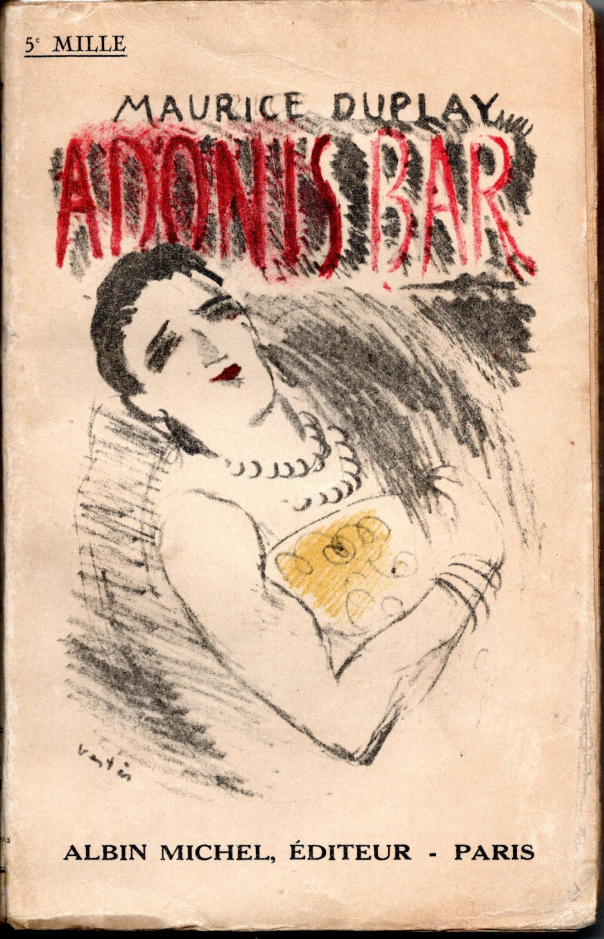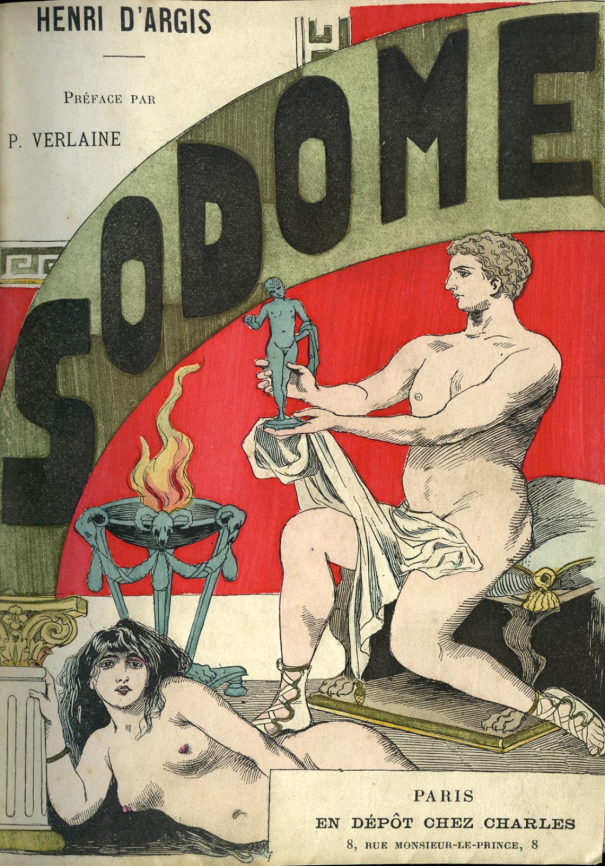This text was presented at the Against nature event organized by Pierre-Alexandre Mateos and Charles Teyssou at Lafayette Anticipations, in conjunction with Cyprien Gaillard’s HUMPTY \ DUMPTY exhibition.
Using Hocquenghem’s post-FHAR writings (La dérive homosexuelle, Le Gay voyage, Oiseau de la nuit, Race d’Ep) and their revival in so-called anti-relational (Bersani, Edelman) or rather counter-civilizational theory, the aim is to determine perverse counter-geographies. This speculative gesture is based on a cross-genealogy of intimacy, the homosexual subject and the city, through the intermediary of hygienism, homosexual drift and flirting, as part of both a particular topological flair and a strong antisocial aim: to depose disciplinary intimacy - and, ultimately, familialism. It is disciplinary hygienism, insofar as it provokes the presence of what it circumscribes and exhibits it under the pretext of concealing it, that is the target of a certain homosexuality (of urban dissidence) through complicity and concealment.
1. THE INTIMATE OR ACCOMPLICE: “EVERY ACT LEAVES A TRACE” – TIME OF THE CRIME
As if bodies were not separable from their power of density, from their power to create mass, and to ruin in principle all interval and all distance, hygiene converts bodies into idealities capable of analyzing masses: behaviors. The city has only become this machine for (re)training individuals on the condition of this idealization of bodies in behavior. [1]
I would like, from an opposition to be created, that of conspiracy and intimacy, to play with the topographical outline of perverse imaginations. By first simulating a genealogy of the urban-uranist problem – this word uranism from Karl Ulrichs, from hygienism, constrain the moment of complicity. In this genealogy of the urban-uranian problem, as a key moment, hygienism has appeared with insistence since the middle of the 19th century, and which intersects with the constitution, through law and medicine, of homosexuality. In this legal-medical knot, the homosexual emerges – to which the Uranist responds as the first figure of contestation or epistemopolitical resistance. Perverse research, entwined with the city, encounters hygiene and the constitution of a precise space, place of the external and internalized disciplinary, intimacy:
The constitution of modern spaces is therefore the formation and formalization of ideal systems of relationships whose relata are idealities: they are not made with bodies, but with behaviors. Public hygiene has developed a “science” of behavior and feelings by repressing bodies. [2]
We can roughly consider that the thought which governed the city until the Charter of Athens (1933) is a hygienist thought which seeks to protect itself from the consequences that industrial capitalism produces by the crowding of workers: crime and illness. The discourse on which we settle is not that of communication – nor of a theory of communication or cybernetics – but that of contagion and a true metaphysics of miasma: proximity produces the pathogen and the criminal – The urban planner meets the criminologist:
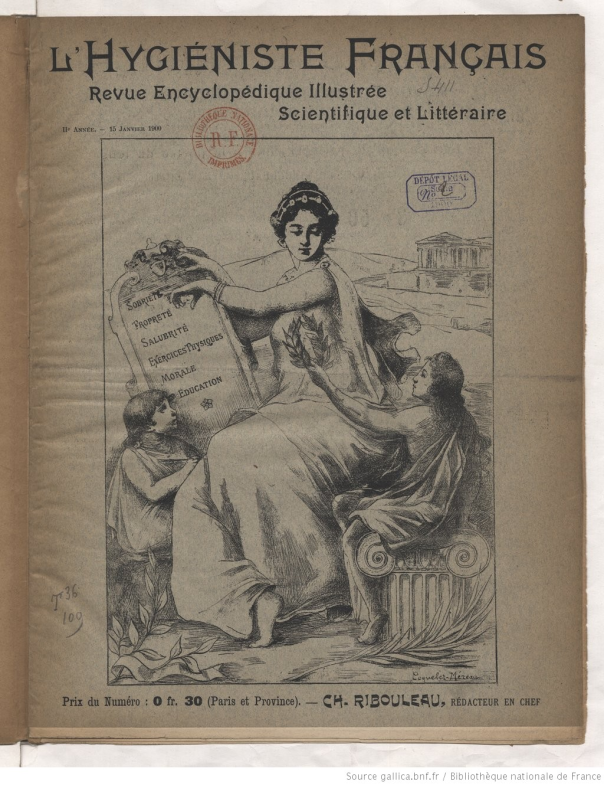
By seeking to eradicate debauchery by establishing a science of non-corporeal behavior, the hygienist, this moralist of the second half of the 19th century, undertakes to counteract all bodily swelling, all erotic behavior: the hygienist discourse constitutes the the intimate space (the habitat). The bedroom trumps the cabaret and the bad places. Thus, housing gives rise to behaviors specific to territories specially designed for them. All of these housing disciplines focus on domestic relations; they are “disciplines of the tiny” [3]: technology of interstices, of intervals – always the danger that it fucks outside the four walls of the habitat. This is because the entirety of everyday life must be domesticated so that the 19th century hygienist slogan could be: “Maintain political order in the midst of moral disorder.” [4] Everything that could threaten public order is contained in the smallest act - which must be scrutinized, penetrated with the police gaze.
From intimacy, we can distinguish two constitutive moments: the first as a moment of
classical intimacy, based on a psychology of the soul (17th century) concomitant with the establishment of the subject of modernity; the second disciplinary intimacy as the creation of a space for controlling bodies (19th century) centered on collective vices and leading to the structuring notion of habitat.
However, we detect, as on a body covered with small shivers, sudden resistance to intimacy, a sort of therapeutic: at the first, it is Sade’s Society of Friends of Crime - that of permanent destruction and conscience and of the subject through crime (a morality of apathy) and which brings dark impulses into play against rational clarity; to the second, there are the lumpenpractices of which the most obvious, the most central, is that linked to carnal vice and which is divided into two close subjectivities: the prostitute and the homosexual. These two intimacies, to be understood differentially, are complementary: it was a matter of developing the substantial family against bad subjectivities (prostitute and homosexual), the latter understood and established legally and medically as threats. A family police force was then created, a precise relationship between society and family which we called: familialism. It is hygienism which constituted intimacy as a sort of objective surface for questioning individual behavior and joining together crime and pathology; the enclosed space of the habitat producing an intimacy, protective from external threats.
2. THE HOMOSEXUAL SENSIBILITY OF THE TRACE – TIME OF THE PLOT
Because the vicious circle abolishes, once and for all, alongside identity the meaning of acts and demands their infinite repetition in a complete absence of a telos, it becomes the selective criteria of experimentation within the conspiracy itself. [5]
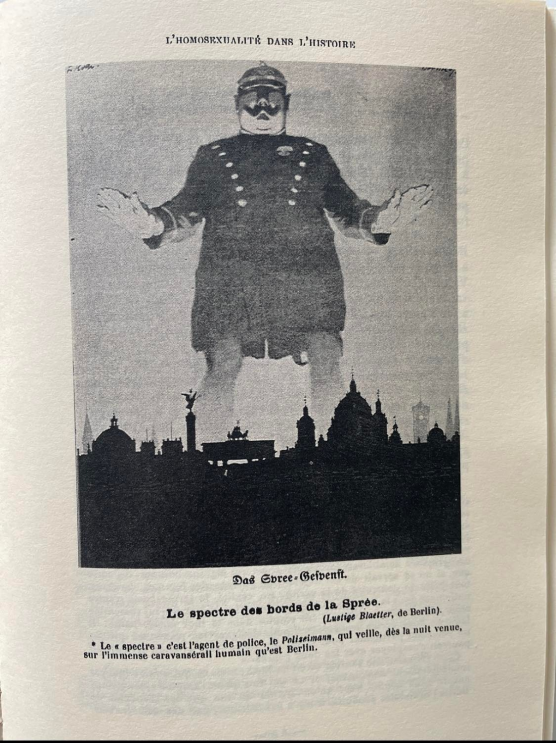
We understand that with this policing of families, the repressive apparatus hardens through the agent who stands as if on top of the city, according to the panopticon, and controls its interstices. Criminology at the beginning of the 20th century, with Edmond Locard, the father of criminalistics, stated: “Quiscunque tactus vestigia legat” (Every contact leaves a trace). From a sliding game between crime, complicity and the hidden, it would be necessary to manage to make it the watchword written on the frontispiece of dissident counter-geographies: every contact leaves a trace. It is a
coital ephemeral which leaves traces that homosexuals, fine geographers of cities, recognize and which Hocquenghem called the topological flair of homosexuals:
A city map is a hunting territory. And flirt, a way of reading it, this plan, which soon covers it, erases it, makes it illegible to anyone other than myself, until it escapes, crumpled and damp from having been held for so long, through the window of a pop tram or a yellow taxi. Because my ghetto is not a portion, a fraction, a member of the city. It is spread everywhere, another meaning – minor – given by habits instantaneous, by first encounters, by geography, smoky and terribly precise in detail, evenings where alcohol and drugs set the benchmarks. [6]
The complicity that arises in bars and cabarets presents itself in a fascinating way, but it is much more dislocating in street cruising. Here opens the new topos and a redefinition, a resumption of the hidden, understood in opposition to intimacy - because disciplinary intimacy cannot tolerate the hidden, each interstice must be controlled and corrected; it is about thwarting the false appearance of ’at home’ of intimacy through the hidden - disciplinary intimacy stifles possibilities, the hidden exacerbates them behind the apparent tranquility in that every place is potentially a cruising zone and of fucking.
But moreover, we must grasp the disarticulation of identity. Understanding this then: the homosexual disarticulates his own identity (it is a gesture of expropriation), an identity which has been shaped by the disciplinarian. Production of a new subjectivity through flirting, through the hidden - what Hocquenghem’s drift covers. It is here, from a proposition that can be described as decadent, identifiable in Jean Lorrain through his Tales of an Ether Drinker from 1895, in this literature of the cursed character of the closed habitat, bad accommodation. This decadentist proposal questions the displacements of the hidden in the external, so-called public space - to tell the truth it is a question of a deactivation of the private and the public - bringing into play against the intimate, the notion of complicity in which the power of the carnal. This carnal inscription, persistent trace, is not understood as a resistance to the massification of homosexual behavior - the regulated becoming-consumption in cruising and party places, the formation of the pink ghetto (pinkwashing) - but a very strong resistance. older and more solidly anchored, a sort of desiring neo-archaism which can be reactivated in and through the dissident practice of drift: printed, traced refusal of intimacy. A way of inflicting wounds on the city, according to Hocquenghem’s expression, as well as on disciplinary intimacy.
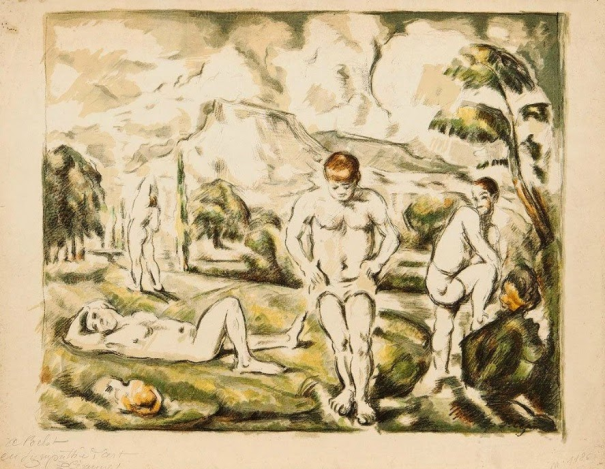
The homosexual drift is understood as a disidentification, this fleeting way of no longer conceiving oneself as an individuated subject but as an incommunicable experience. The homosexual disarticulates his own identity which has been shaped by the disciplinary - it is a gesture of expropriation of perversion, that of diverting a practice from its reproductive goal and from what has been imposed on us by legal discourse and medical as relating to properties (the specialist who would say: “It is indeed the characteristic of homosexuals that ...”). Thus, the production of a new subjectivity through flirting, through the hidden: this is what Hocquenghem’s concept of drift covers. It is always this that Lee Edelman replays in The Impossible Homosexual: ’Homosexuality is constituted as a category, then, to name a condition that must be represented as determinate, as legibly identifiable, precisely insofar as it threatens to undo the determinacy of identity itself; it must be metaphorized as an essential condition, a sexual orientation, in order to contain the disturbance it effects as a force of dis-orientation.” [7]
Homosexuality, in that it gets rid of itself, a sort of homosexual defeatism, was able to
embody the most frontal attack on intimacy and therefore on a certain Western relationship between the hidden, the intimate and crime. This so-called anti-relational or anti-social thesis [8] is understood from its productivity: homosexual desire secretes a movement of dissolution of the disciplinary geographies which saw it born, a tendency towards this disappearance or abolition, by producing other forms of relationality passing through flirting and fucking - the relationship is complicit and non-mediator. Or to put it another way, homosexual desire is:
– On the one hand a destitutive use of the anus — at the same time as the anus loses its function of evacuating waste to become a site of pleasure (an anti-hygienism), it is a question of attacking the disciplinary institutions based on familialism.
– On the other hand, a desirous use of the anus — production of new relationships, improbable connections, desire for everything that can penetrate it. In this sense, the term “anti-relational”, used by critics of this thesis, seems far too weak.
Thus, a complicity produced by an expropriation of the other - an expropriation understood as the proper, the intimate, is grasped and deactivated. The plot is absorption in the diversion in progress - the game of conspiracy and complicity, the game of secret flirting and the suspension of consciousness by the crime in progress. It is the fantasy that awakens once institutional life (urban life and its rules) and moral life (intimate conscience) are neutralized. From the first glance, in this relationship to an unknown face, the dart of desire is planted. More than a crumbling of innocence, this is the hasty step of a revealed attack on privacy. No intimate relationship, no veil of modesty, but complicit relationships raising the desire for co-involvement in a crime - that’s the great theme of Jean Genet.
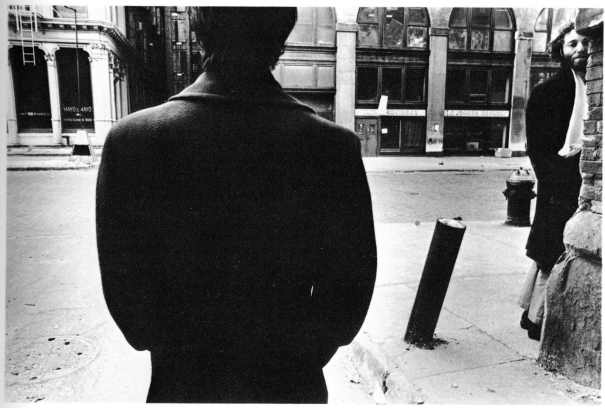
Faced with this incommunicability of an experience that the rational language of the disciplinary can only apprehend through repression and judgment - operating a moralistic reductionism of experience - we should make the first gestures of a counter-topography of this anti-hygienist proposition, that of drifting homosexuality.
3. SODOMISTIC COUNTER-TOPOGRAPHY: TENDER VS ALEXANDRIA MODERN
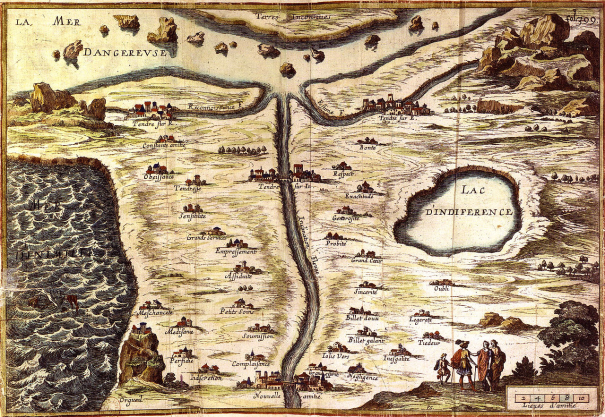
{{}}
The Carte de Tendre, an imaginary plot, was gradually developed in the 17th century, as an extension of Mademoiselle de Scudéry’s novel, Clélie, histoire romaine. The incarnation of Les Précieuses, this imaginary topography has long been represented as virtuous – the rules leading to marriage, a guide for the suitor. It should rather be understood as an experiment that is not marked out, but open; because it only produces what we think it would eliminate: confusion. Understand the sentence in Clélie: “There are no paths where we cannot get lost”.
Starting from complicity in the crime, it would be a question of twisting or carrying out a perverse twist to the Carte de Tendre and to its own regime of modernity - which is not yet that of the disciplinary, but of a certain psychology of the intimate which will make it possible, from a perimeter of all affective experience. In this gesture of a sodomistic counter-topography, our map would take the name of Modern Alexandria, the last imaginary city of Hocquenghem’s Gay voyage, his Hellenistic New York of the 1st century. City of an impulse drift between two men.
Taking up the map of Tendre through the Homosexual Drift and the Gay Voyage by purging it of all telos, is done through the desiring use of the anus, that is to say an anus freed from the functionalism of the organs, which does not know no finality except the dissolution-penetration-dissolution spiral. It follows the non-teleological movement of Hocquenghem’s short story “Oiseau de Nuit” [Bird of the Night] by posing the principle: the journey of drift is a process of disidentification from familialist disciplinary norms in favor of a new, resolutely counter-civilizational subjectivation and against the intimate: it produces a new subjectivity (the mad one) whose goal is to pervert new beings, to trigger a disidentification in them. This is such an unusual thing as a doctor of perversion and with what manner, with what language he fulfills his office!
The driving principle of drift is a principle of evolution: a spiral movement makes present desires which are born, in the unforeseeable of the encounter - the fortuitous versus the teleological. The “starting” point is therefore that of complicit initiation; a sort of Bildungscruising, based on a protagonist, present in all the literature that followed Genet and Hocquenghem: the mad thug. In the film by Lionel Soukaz and Guy Hocquenghem, Race d’Ep, the initiation begins along the ill-famed urinal and will follow the movement of a spiraloform drift - refusal of any circularity, that is to say of a self-identity. What this counter-topography proposes, following this gesture of an initiating perversion, is to replace precious cities with other places, just as imaginary as they are rooted in memories and affects.
Simulating the Map of Modern Alexandria, we can place a few places pell-mell [9]:
– the Luxor: with its rhapsody of jeans during Jason and the Argonauts by Don Chaffey. Peplum punctuating Uranian coitus from the 60s and 70s.
– The banks of the Seine with the two thugs, not bad [10], from Hocquenghem.
– Le Méry, known as a adult movie theater. Place de Clichy --- the setting for Jacques Nolot’s movie, La chatte à deux têtes.
– L’Adonis-Bar from the novel by Maurice Duplay: bar opened by the young Michto, Adonis with his transvestite friends in Montmartre — most certainly at 2 rue Berthe.
– Not far, the Duplex, where I sucked off a guy in his fifties a few weeks ago.
– L’Esclave in Avignon, a stopover for theatrical faggots one month a year.
– Any hidden place, in the color given to it by François-Paul Alibert in his novel Le supplice d’une queue

– Jean Lorrain’s apartment, where homosexuality is high on the ether by abhorring intimacy (discourse of homosexuality which tends to leave the habitat as a place of horror: decadentist impulse).
– The Argos Club in Amsterdam (closed). So, a motorway rest area, decorated with a few traces of ketamine, will do the trick before getting back on the road – a really winding drift.
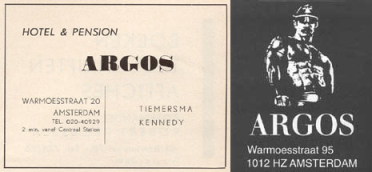
–The Lab, where every river takes its source.
– The Tuileries, a sort of first Garden of the Pervert.
– The Marais, where, in an alley, I once again sucked off three guys in a row, crime after crime, also around forty-fifty years old, a month ago. A tap on the shoulder to let me know that a neighbor, an early riser, was staring at us. First coitus interruptus which reaffirms the ephemerality of the drift.
Let us clarify: If this drift punctuated by places of consumption, no one gives credit to it - the moral debt is not established there at all: the currency of rigor during this journey is living currency, whoever is a body is enjoyable and produces value.
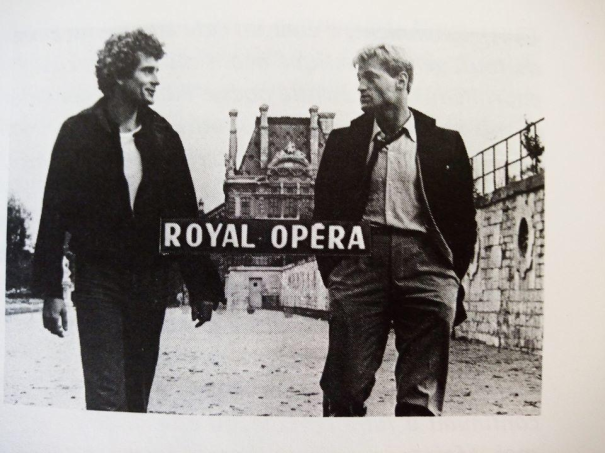
– Guy Hocquenghem and the porn actor Piotr Stanislas: drift-discussion which is understood as the moment of a homosexualization of Rameau’s Nephew.
– The El Dorado of Berlin in the 20s and 30s where Christian Schad paints The Guide to the Lustful Night at the Heart of the New Objectivity.
– Jean Genet, Funeral Rites: “J’encule le monde !”, a dismissive tirade of a few syllables against all the books of Civilization.
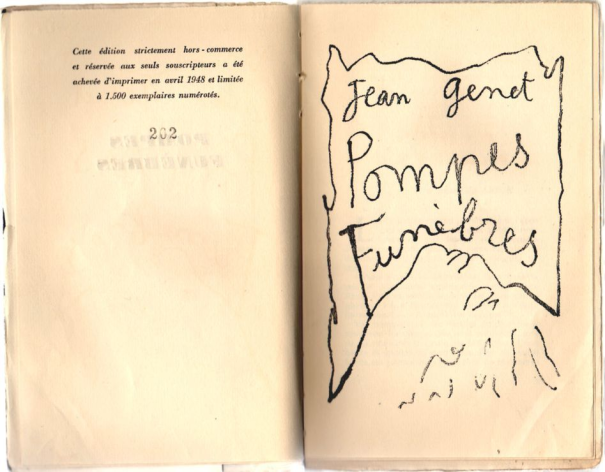
– The University of Vincennes — passage required by Hocquenghem — has become a maintained homosexual amusement park (you can access it through Porte dorée).
– The Catacombs in the South of Market neighborhoods of San Francisco where Gayle Rubin dominated and fisted Michel Foucault. Epiphanico-anal place since he discovers through this initiation, in a Eureka! filled in him: “Power is exercised more than it is possessed” (History of Sexuality, volume 1: the Will to Knowledge).
– The School of Fine Arts in the 6th arrondissement where the General Assemblies of the F.H.A.R. (Front Homosexuel d’Action Révolutionnaire) and homosexual orgies took place (on six floors of cruising, Hocquenghem tells us in L’après-Mai des Faunes).
{}
{}
– Sodome by Henry d’Argis, first homosexual novel and prefaced by Verlaine. D’Argis in relation with Pierre Loti. We will appreciate the long description of a Parisian sauna near the Opera.
– The tourniquet by Saint-Jean Genet, ontological annihilation as the depths become pregnant with the works of his lovers.
– The ruins of the Institut für Sexualwissenschaft by Magnus Hirschfeld prompting us the speculative question: How to live and think among the ruins? (Ursula Le Guin and Donna Haraway).
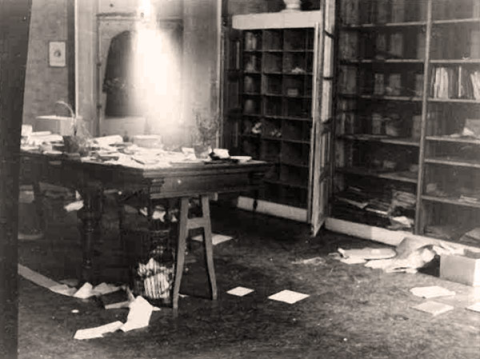
– Ramier Island in Toulouse with this excitement in the post-industrial proliferation following the explosion of the AZF factory in 2001.
– Any church presenting a Saint Sebastian and any tree in a park becoming the scene of a sex-martyr. For example: The dream of Ogier II (or the Fustigation) by Pierre Klossowski in The Immortal Adolescent and which recalls in the Book of Lamentations of Jeremiah of the Old Covenant:
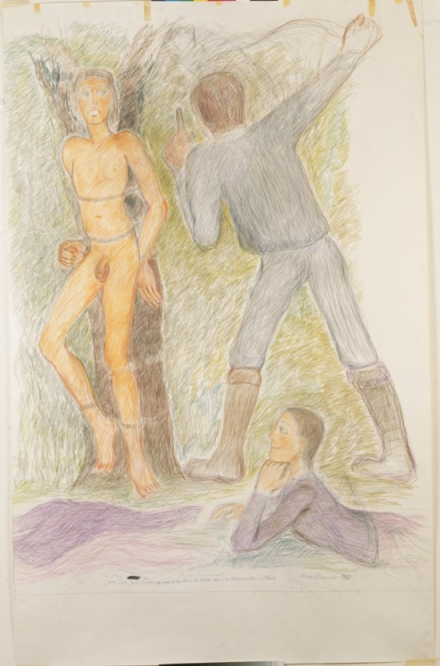
For me he is a bear lying in wait, a lion in hiding
He diverts my paths, tears me to pieces, he has made me a devastated man. He drew his bow and set me up as a target for his arrow
He has brought the threads of his quiver into the depths of my being.
– Ostia, November 2, 1975, Pasolini. With a detour to Stazione Termini where Pasolini recruited his dangerous lovers.

– The cave of Saturn – the other name that Rabelais gives to the anus – where we devour our own children while shitting them. The cycle of civilizational reproduction is short-circuited: the feces are no longer identified with psychoanalytic money, a break in sublimation, but destabilized from the excremental as well as excremental function - we prefer the voracious Saturn rather than the Jupiter (very bad lover).
In the seas of danger:
– Preciado’s Pornotopia apartment: postmodern intimacy and masturbation.
– The Demence Boat: that is to say petro-cruising.
– The European Parliament full of gays with ties — to be avoided especially during their fairies’ period, which takes place one week a year in the Vosges.
– The complementarity of astrological signs (hypostasis of active/passive roles in a post-premodern bestiary).
– Boring coitus type Xavier Dolan (anal sublimation).
CONCLUSION
{{}}
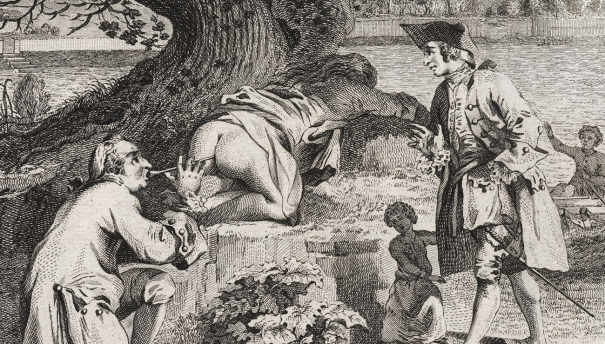
{{}}
“But “understanding” the simulacrum or “mistaking” it has no consequences: the simulacrum, aiming at complicity, awakens in those who undergo it a movement which can immediately disappear; and talking about it will in no way account for what happened then: a fleeting adhesion to this consciousness without support which embraces in others nothing but what could be distracted, dissociating itself from the self of others to make it vacant.” [11]
A sodomistic counter-topography finds its expression in a map made of affects, of experiences that are difficult to qualify as personal, since the self and identity emerge completely unstructured. Momentarily, we come to delirium about this stability of the person; recognizing no boundaries, she is Hocquenghem’s crazy fabulatrice, who secretes her own universe of reference and meaning. Through this complicity in the fortuitous, the protagonists expropriate identities fixed by disciplinary hygiene. A map, with all its ribs, resolutely anal, following a method of simulation, without any reference to a teleological plane - that of reproduction - but only to that of infertile, unengendering enjoyment.
The question then becomes that of initiation into perversion rather than its reproduction. By escaping the surveillance of the intimate, that of the family and the institutions which have set themselves the civilizational mission of not leaving a single body uninvested by them, homosexual flirting determines a way of communicating through complicity - a semiotic instinctual where only these glorious perverts know each other. What is proposed then is to consider homosexual flirting not as a transgression but as a simulation. Indeed, transgression engages in endless failure: it preserves what it suppresses [12] — the heterosexual law is then recognized as universal in the movement that wants to deny it.
Our starting point for the opposition between intimacy and complicity, false as it is, must trigger the overcoming of perversion as transgression: it is artificiality that it product – the existential territories of flirting – which makes possible an opposition understood as a destructuring event: either the counter-civilizational, this counter becoming antagonism [13]. It is therefore a cartographic gesture which must express initiation; this expression being in no way transgressive but simulative: it itself produces, in a game of fantasies and displacements, in an effective artificiality, the destructuring of straight thought. It simulates and not represents: because itis the power of the false which here shatters the rational structures of architectural and hygienist discourse. Perverse flirting requires no mediation in its exercise, it is immediately connected to space – and blends into it. This is the whole point of perverse complicity in that it occurs without any authority or authority – neither the gaze of the father nor that of the State, nor the reproductive injunction which m Because this complicity imposes the excess of desire beyond the reproductive goal, it produces territories which are endowed with their own rhythm and values. We will then recognize in this power of the false another way of saying and writing the threat.
[1] L. Murard et P. Zilberman, Le petit travailleur infatigable. Villes-usines, habitat et intimités au XIXe siècle, Recherches, n°25, 1976, p. 107. [My translation]
[2] Ibid., p. 108. [My translation]
[3] This discipline of the tiny is itself analyzed in the third chapter of the work Le petit travailleur infatigable.
[4] The expression [in French: “Maintenir un ordre politique au milieu d’un désordre moral”] is from Comte in A Discourse on the Positive Spirit (1844).
[5] P. Klossowski, “Circulus Vitiosus.” Translated by Joseph Kuzma. The Agonist: A Nietzsche Circle Journal 2, no.1 (2009).
[6] G. Hocquenghem, Le Gay voyage : guide et regard homosexuels sur les grandes métropoles, Paris, Albin Michel, 1980, p. 9-10. [My translation]
[7] Lee Edelman, “Homographesis : Essays in Gay Literary and Cultural Theory de Lee Edelman (New York : Routledge, 1994), p. 14.
[8] I reject the terms as well as the too brief analysis given by José Esteban Muñoz in Cruising Utopia. On the contrary, an explanation which would oppose a “relational” theory and an “anti-relational” theory says nothing about the notion of relation in the name of which it is made – it even says nothing but the whole since by confusing relation and mediation, it remains a thought trapped in the totalization which it nevertheless seeks to deactivate. Here we should rather consider the problem of communicating an incommunicable which we experience and whose content of the experience is developed viscerally - the relationship is then posed from the fragments which we experience at the same time. within oneself, this self being completely dislocated ( disidentification).
[9] We will forgive what the impulses throw here without worrying about putting them into a bouquet: the incommunicable produces its own connection and I leave here wiser and learned homosexuals to find some rationality there.
[10] “I was walking down a lost street, in a peripheral district, looking for a disreputable urinal. Under a bridge, two thugs were waiting, leaning against their motorcycles. And when I passed, they shouted at me, not unkindly: “Race D’Ep!” » Since I was drunk, it took me a while to understand. Inverts don’t speak verlan. Race of Ep, for pederast. For a moment, I felt the shadow of another race floating. I felt this cry less as an insult than as the summary evidence of my belonging to another world, to another History. » Race d’Ep! Un siècle d’images d’homosexualité, Bordeaux, La Tempête, 2018, p. 29. [My translation]
[11] P. Klossowski, “Le simulacre dans la communication de Georges Bataille”, La Ressemblance, Marseille, ed. Ryôan- Ji, 1984, p. 24. [My translation]
[12] In his analysis of Sade in 1947 and Bataille’s transgression, Klossowski speaks of a conservative suppression : transgression necessarily affirms the existence that is denied or transgressed.
[13] The political question remains: can civilization’s opposition between innocence and guilt be temporarily replaced by perverse non-innocence? Rather than producing innocent desirous people through education (as Schérer analyzed in L’Emile perverti), the complicit group seeks to initiate non-innocence.
28 Décembre 2020
« Du côté de l’homosexuel, il y a dans ce corps pénétré une perte de pouvoir à laquelle le pouvoir d’inquiéter doit venir répondre politiquement. »
Par Quentin Dubois
28 février 2022
« L’anus sera producteur de vie »
28 mai 2022
« Fiévreuse plébéienne est le premier traité dissident (transpédégouine) de physique. »
« Car, je le redis encore, c’est l’anus qui est le siège des impulsions »

